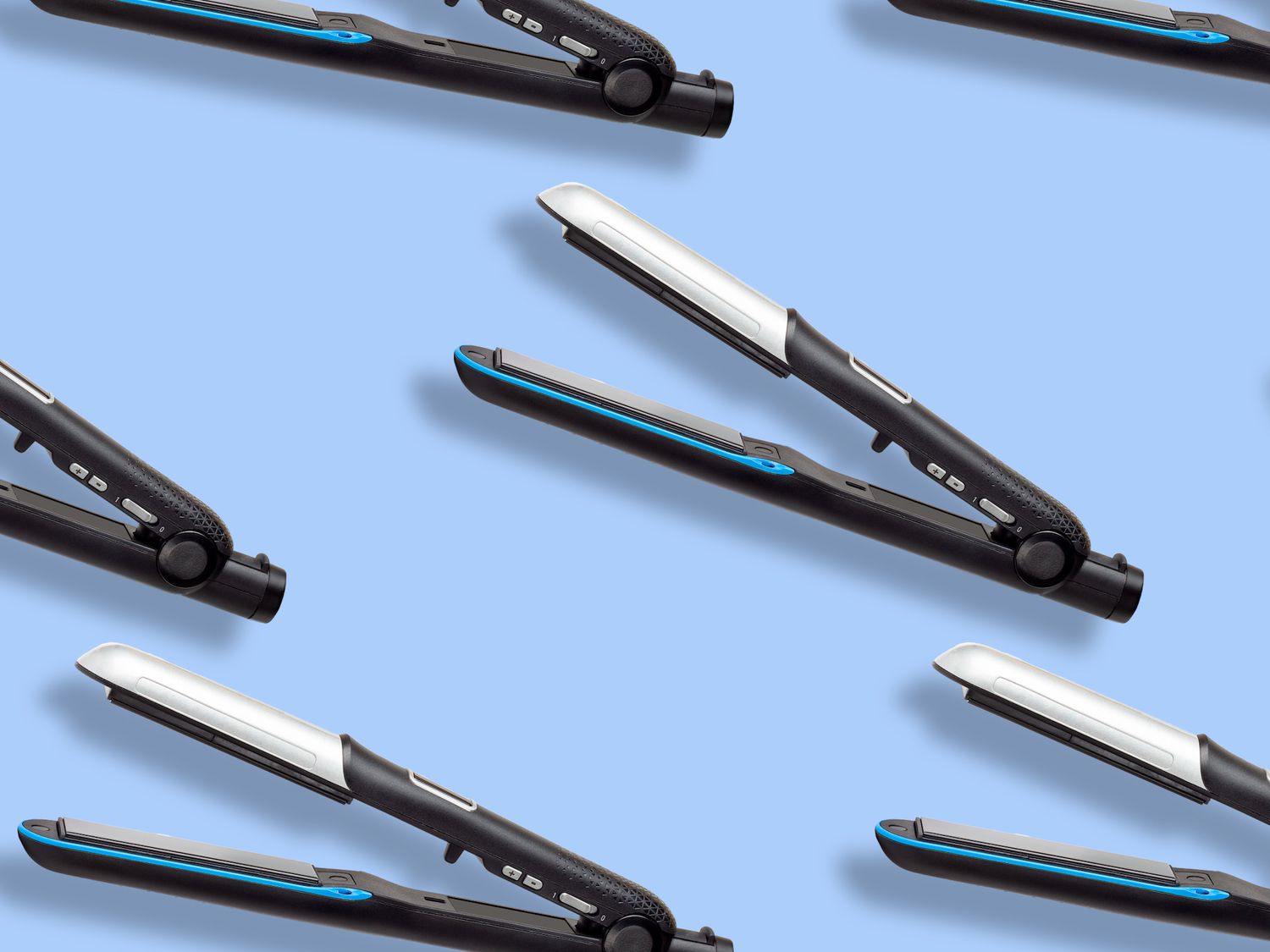
Getty Images
There are some days when you want your hair to be smooth, sleek, and shiny—and one of the quickest ways to achieve that is by straightening your hair. The only problem? Using a flat iron or other hot styling tools can cause damage, especially if you use them incorrectly or too much. Not to mention, the process of safely straightening your hair is tedious—you need to apply heat protectant, be gentle on breakage-prone areas, and use the right temperature for your hair type. So, it’s understandable if you’ve previously found it overwhelming and skipped some steps.
So how often can you straighten your hair without damaging it, and how do you properly heat style your hair in order to avoid breakage? We spoke to two hairstylists to find out. Keep reading for everything you need to know about straightening your hair without damage, including tons of expert tips and tricks.
Meet the Expert
- Jason Lee is a hairstylist, colorist, and the founder of Mela & Kera.
- Aaron Grenia is a hairstylist and the co-founder of IGK Hair Care.
How Often Can You Straighten Your Hair Without Damage?
Like most things, the amount of heat styling your hair can take without damage will vary by your hair type, the condition your strands are in, and your technique. Usually, it’s best to straighten your hair a maximum of two or three times per week, but it really depends. Technique goes a long way, whether you prefer wearing straight styles more often than not or are working with preexisting damage.
In general, straighter, finer strands are more prone to damage, so if your hair falls into that category, you'll want to minimize how often you straighten it and keep the temperature low. Wavy, curly, and coily textures will need a somewhat higher temperature for the flat iron to be effective, but you'll still want to be mindful of how often and how long you apply heat to your hair. Ahead, our experts break it all down further by hair type.
Coily Hair
Using tools made for thicker hair will make a big impact on how you style coily hair. A focus on keeping the hair moisturized is also important to prevent breakage and damage.
- Apply a heat protectant to the hair before blow-drying. “Coily hair tends to require more hydration, so products that contain shea butter and oils such as castor and jojoba oil are a great way to prep the hair prior to heat styling,” Lee says. “Use a great leave-in conditioner, like Tracee Ellis Ross’s Pattern Leave-in Conditioner ($25), to help with detangling as well as prepping the hair.”
- Lee recommends using the heat of a blow-dryer and a good Denman brush to straighten coily hair.
- Start on towel-dried hair, going section by section and pulling the hair straight using the Denman brush. “Once straighten and dried, I would then take small sections using the chase method, which is taking a comb through the hair with a flat iron to really press that hair smooth and straight,” Lee explains. “The idea of smoothing out coily hair with this technique is less damaging. Coily hair can be more fragile than other hair textures, so you want to be very gentle and careful doing this.”
- Curly and coily strands can withstand higher heat temperatures. Grenia advises staying between 400 to 420 degrees Fahrenheit to avoid damage. You should also keep the iron moving to make sure it’s not sitting in one spot on the hair.
- Once styled, Lee recommends finishing with a lightweight oil-based finishing product to help add further hydration.
- You can heat style your hair as many times per week as you want. However, it’s best to limit the amount of time that you use hot tools to prevent damage and dryness—especially on coily strands.
Curly Hair
Since curly hair needs moisture, it’s best to limit how often you use heat to keep the moisture intact. Products like moisturizing shampoos and conditioners, heat protectants, and smoothing balms are all helpful additions in keeping curly hair free of damage when straightening it.
- Before you begin, layer a heat protectant like the IGK Good Behavior 4-in-One Prep Spray ($32) and Good Behavior Spirulina Protein Smoothing Balm ($34). “Perfect for thicker, coarser hair types, this heat-activated, super smoothing transformative formula starts as a thick cream and melts immediately into hair when blow-drying, giving lasting sleekness and shine without feeling heavy or weighed down,” Grenia tells us. Heat protectant is important when using hot tools to seal your strands and reduce breakage.
- Another important detail to keep in mind is that curly hair can withstand higher temperatures. “Hair is more resistant and needs a bit more power, so I recommend starting at 400 and going no higher than 420,” Grenia advises.
- Using high-quality heat tools, like the Dyson Supersonic Hair Dryer ($429) and the GHD Platinum+ Styler ($279), will also have an impact in preventing damage to curly hair.
- Limit how often you straighten your hair to prevent damage. Ideally, curly hair shouldn’t be heat styled more than two times a week.
Wavy Hair
Wavy hair requires less effort to straighten than curly and coily strands, though it's still a bit more than for those with straighter textures. "The best way to straighten wavy hair with minimal damage is to use a blow-dry hair brush to gently stretch out the wave to a smoother, straighter finish instead of the round brush/blowdryer combo," Lee explains.
- Start on towel-dried hair, using a blow dry cream (such as the Mela & Kera Balayage Exceptionnel Exquisite Blowout Crème, $36, a favorite of Lee’s).
- Once you have your heat protectant product evenly distributed, go section by section, using the blowdryer hair brush to smooth out the hair. “You need heat and some pulling action in order to change the pattern of wavy hair to a straighter finish, but you don’t need to really pull as hard as you might with curlier or coily hair types, so the gentler you are on the hair type, the better,” Lee explains.
- Keep your temperature between 250-375 degrees Fahrenheit to stay on the safe side. “Finish with a ceramic or tourmaline flat iron to really press the hair into a smoother finish, helping to control any wave,” Lee says. “On wavy hair, keep the heat settings lower since you’re just finishing the hair—it doesn’t and shouldn’t be set to the highest heat.”
- In general, you should try to limit the number of times that you use a straightener on your hair. “If you are worried about damage or trying to repair damaged hair, it’s important to give your hair a break from hot tools as often as possible,” Grenia advises. “That being said, if you are someone who prefers using a heat styler daily, just be sure to use really reparative products and ingredients, and always use a heat protectant.”
Straight Hair
When it comes to straightening already straight hair, there isn't much you need to do to get it sleek. However, you'll still want to cut down your styling time as much as possible to avoid heat damage, plus there's several steps to take in the process to try to preserve strong, healthy strands.
- According to Lee, the finer the hair, the lower the ideal temperature, so you’ll want to keep straight, finer strands at as minimal of a setting as possible.
- Before you start straightening, layer stylers with heat protection as you go from wet hair to prep and styling. Grenia recommends using the aforementioned IGK Good Behavior 4-in-1 Prep Spray: “It’s the perfect primer for any hair texture because it gently detangles to glide through hair with ease while nourishing and providing heat protection with 24-hour frizz control.”
- For straight hair, the entire process should be relatively quick and easy: After your hair is dry, simply run a flat iron over it until it’s smooth. Since your hair is already straight, it shouldn’t take more than five minutes to achieve an ultra-sleek result.
- Since straight hair tends to have finer strands, it’s best to use hot tools as little as possible to avoid damage to your hair. “It’s safer to use a lower temperature setting to avoid damaging the hair and causing any breakage,” Grenia tells us. “I recommend starting at 350 [degrees Fahrenheit] and going no higher than 380 for fine, thin hair types.”
The 12 Best Hair Straightening Products of 2024

